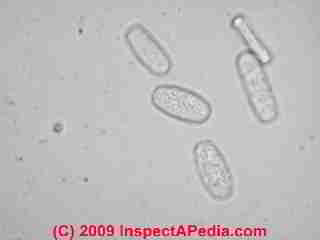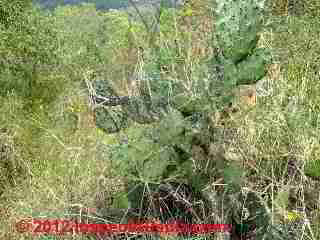 Fungal / Mold Growth on Prickly Pear Cactus - Opuntia Mill.
Fungal / Mold Growth on Prickly Pear Cactus - Opuntia Mill.
Daniel Friedman, San Miguel de Allende, Guanajuato, Mexico, 2012
- POST a QUESTION or COMMENT about problems with mold growth on cactus plants: cactus mold identification, cactus mold causes, & cactus mold remedies
Prickly Pear Cactus Mold - Mold on the Nopal.
Abstract: This article describes mold growth on pricklypear or Mexican Nopal cactus plants in the wild and on cactus kept as houseplants. We investigate the cause, cures, & prevention of mold infection of Mexican Pricklypear cactus plants, the effects of mold growth on cactus plants, and the identification of mold genera/species commonly found growing on cactus.
InspectAPedia tolerates no conflicts of interest. We have no relationship with advertisers, products, or services discussed at this website.
- Daniel Friedman, Publisher/Editor/Author - See WHO ARE WE?
Cactus Mold
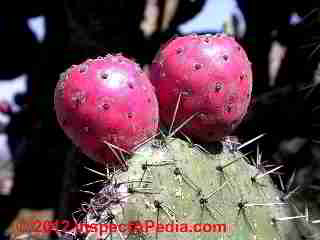 Daniel Friedman, San Miguel De Allende, Guanajuato, Mexico
Daniel Friedman, San Miguel De Allende, Guanajuato, Mexico
The Mexican Nopal, or in English "prickly pear cactus" or "Barbary Fig cactus" is a species or group of species of Opuntia Spp. within the Cactaceae family. While some sources [22] claim over 200 species in that group, the USDA lists 59 species and 75 accepted taxa within the Genus Opuntia Mill.[20]
I am particularly interested in fungi found on species of Nopal found at altitude in more wet or humid highlands of Mexico.
These include fruit-bearing pricklypear species (Opuntia ficus indica) that are widely used as a food (both the cactus fruit or Tuna and the younger cactus pads or nopalito) and drink product (an intense purple juice in water) in Mexico as well as an export product in the form of Nopal fruits, Nopal juice, and in power and cosmetic forms. [22]
Some might think that because cactus plants generally grow in dry locations that they never suffer from fungal attack, but that's certainly not the case. The page top photograph of a mold-infected Nopal (pricklypear) cactus plant was taken in Yerbabuena, Colima Mexico. Yerbabuena is a tiny village located at a comparatively high altitude and close enough to Mexico's Pacific coast to receive more rainfall than some other areas of the country.
I have observed both superficial fungal growth on the intact skin of cactus plants and plants injured or destroyed by fungal attack. Experts report fungal invasion of cactus plants by other vectors such as through wounds, cuts, and direct penetration of the cactus. An online provides live links to references and to larger images of the photographs herein.
See https://InspectAPedia.com/Cactus_Mold_PAAA_2012.php
Appearance of Mold on Cactus: on the plant & under the microscope
Black & Other Dark Colored Molds on Cactus Plants - seeking identification details

Mold growth on cactus is more common in areas where cacti such as the Mexican Nopal (below left) grows in higher and less arid regions such as la Yerbabuena, near the foot of the volcano above Colima, Mexico.
(Photographs by DF, la Yerbabuena, Colima, Mexico, November 2011) Pricklypear cactus (Opuntia Mill. are also found in the U.S. in Florida and Hawaii as Opuntia cochenillifera.
Our Mexican Nopal cactus mold photo (at left, 1200x) seeks expert help with confirming its identity, and is discussed below.
Below (right) and tentatively identified as a Lasiodiplodia theobromae -like fungus are microscopic images (approximately 600x) of the mold we found growing on the Mexican Nopal cactus.
The conidia (spores) are obovate to pyriform, with a thick cell wall, dark brown, smooth, with a single transverse septum near the base. They appear to grow in opposed pairs on either side of the hypha. The upper larger segment of the spore is generally darker than its base.
We also found, no surprise, species of Cladosporium sp. on this cactus surface. Some experts report that superficial molds such as powdery mildew may appear on some cactus houseplants. Mildew on cactus will appear white or gray-white and is principally a cosmetic issue. [1]
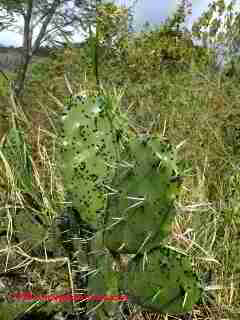
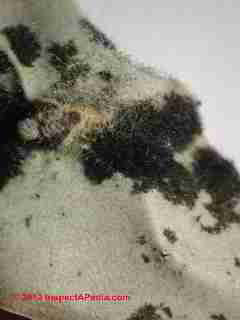
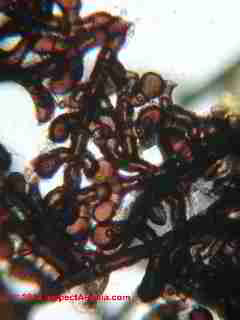
Lab microphotographs and work to identify the black cactus mold shown above are in process - Ed.
List of fungi associated with cactus plants

At above left our photo shows a typical colony formation on the surface of a Nopal cactus plant, viewed by stereo microscope. Here are some of the many fungal species associated with cactus plants and/or the soils around them.[16] Keep in mind that many fungi may be helpful to certain cactus species both in soils and at cactus roots and at other plant locations or in controlling cactus pests[13][19].
But some fungal genera/species are indeed reported to invade or attack and damage or even kill cactus plants including:
- Fusarium sp. [2]
- Aspergillus fumigatis [through plant soil][12]
- Aspergillus niger [through plant soil][12]
- Aspergillus parasiticus [possibly]
- Colletotrichum sp, (anamorph: C. gloeosporioides) (cactus stem rot)[17]
- Fomes robustus (heart rot fungus) [18]
- Glomerella cingulata (cactus stem rot)[17]
- Lasiodiplodia theobromae - a member of the Botryosphaeriaceae/ B. rhodina family, wide ranging plant pathogen, may cause fungal (mycotal) keratitis and stem-end rot, a citrus plant disease, possible cause of nail and skin lesions on humans [5][6]
- Phialocephala virens
- Poria sp. [18]
- Sporothrix schenckii [12] [human pathogen , Rose-picker's disease]
- [Possibly] Yeasts [10][11] brought by insects
- 22 fungal species associated with cactus plants were identified by an assay of 900 endophyge isolates[14]
White & Light Colored Mildew & Other Molds on Cactus Plants
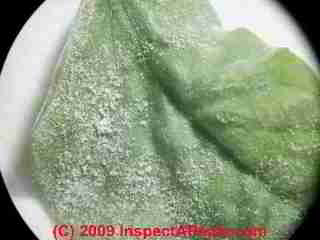
White stuff found on both indoor and outdoor plants (photo at left of a leaf, not cactus) including cactus plants may be mildew,
If the cactus is being kept in a too-wet or too-humid environment. Mildew infection of a cactus is more likely for plants grown out of their native (dry) environment, and when the cacti are kept close to other mildew-infected plants.
Because the skin on most succulents is so thick, mildew may do less damage to a cactus than to other plants.
However other white and light colored molds found in buildings and on some plants can be harmful to people and animals as well, such as some species of Aspergillus sp. and Penicillium sp. See WHITE MOLD PHOTOS for photographs of white mold growth in buildings.
Other "white stuff" we see on cactus plants may be a left-over deposit from having sprayed or washed the cactus plant with vinegar or other solutions.
Watch out: some "white stuff" on cacti and certainly on other plants may be mealybugs not a fungal infection, but deserving action.
Our photo (above left) shows what mildew spores look like under the microscope.
Photographs of mildew on plants are
and advice on curing & preventing mildew on plants is
at MILDEW REMOVAL & PREVENTION
Treatments for Cactus Mold Growth
Some, perhaps most molds molds observed on cactus plants may not actually harm the plants but may remain a cosmetic issue for hobbyists. Popular cactus mold cures include:
- Removal and disposal of the mold-infected cactus part if feasible - suitable for cactus house plants;
- Using a cotton swab moistened with vinegar or with 70% alcohol to clean small infected areas of cacti used as house plants.
Watch out: cactus horticulturists point out that vinegar can be purchased in varying strengths for horticultural and other uses (thus its effectiveness as a fungicide may vary), and it is also reported that using vinegar on cactus may both help and harm the plant, depending on the strength of the vinegar solution, its application, and the plant species. Also, there may be a connection between subsequent cactus damage and acetic acid bacteria. [8] Stan Starbuck reports that while vinegar has been used successfully to treat certain fungal infections on soil surfacesSome plants such as Aloe, Haworthia and Euphorbia suffered small amounts of cosmetic skin damage. Other plants sprayed in the same manner such as Hurenia, Echinocereus, Mammillaria and Rebutia suffered fatal results.[7]
Watch out: furthermore, often "white stuff" that appears to be "growing" on the surface of soil around plants, particularly houseplants, may not be a fungus at all, but rather a white mineral deposit left on the soil surface from watering activities. The "vinegar cure" for this condition is not killing off a mold infection. Instead it is dissolving the mineral salts back into the soil, just as we use vinegar to de-scale a coffee maker.
- For cacti grown as crops, different approaches are needed including attention to mold sources (piles of organic debris nearby) and perhaps dusting the crop with a Bordeaux mixture.
- Avoid over-watering cactus at any time but particularly if it is suffering from mildew or mold growth.
Other Pricklypear Cactus Nopal or Tuna Photographs
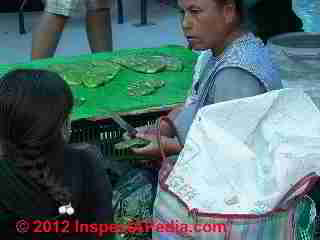
Nopalitos are sold in local markets as well as larger supermarkets and are exported as well. The young nopalito pads are harvested and cleaned of thorns for sale. (Left and below left).
Nopal is sliced into strips or diced, then cooked alone (boiled or grilled) or with a mixture of onions and other herbs, and consumed as a vegetable.
The Nopal fruit or Tunas (see photo near page top and below right) are harvested using a long pole on the end of which may be a forked nail-pair used to hook the fruits. Tunas may be peeled and eaten as a fruit but quite often are immersed in water, on occasion with added sugar, to make a fruit beverage.
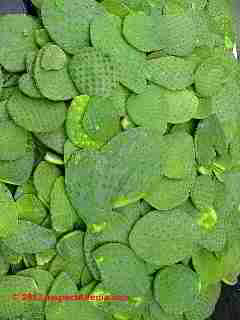
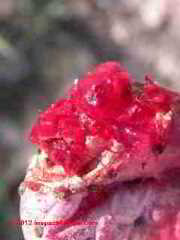
References:
- FUNGAL MOLD GROWTH on PRICKLY PEAR CACTUS [PDF] - Daniel Friedman, 2012
- FUNGAL MOLD GROWTH on PRICKLY PEAR CACTUS [PDF] 13x19" poster - Daniel Friedman 2012
- [1] North Dakota State University Extension Service, Cass County, Horticulture & Gardening, web search 02/29/2012, original source: ag.ndsu.edu/casscountyextension/horticulture
- [2] "Cactus Rot, Prevention, Causesd, Identification & Solutions - Stem Rot [ on cactus plants ]", Cactus Culture, Kada's Garden, web search 02/29/2012, original source kadasgarden.com/Crot.html
- [3] Martin B. Ellis & J. Pamela Ellis, Croom Helm, London, 1988, ISBN 0-7099-5316-X. , Ref: Microfungi on Miscellaneous Substrates, an Identification Handbook, Martin B. Ellis & J. Pamela Ellis, Croom Helm, London, 1988, ISBN 0-7099-5316-X.
- [4] Martin B. Ellis & J. Pamela Ellis, Croom Helm, London, 1988, ISBN 0-7099-5316-X. , Ref: Microfungi on Miscellaneous Substrates, an Identification Handbook, Martin B. Ellis & J. Pamela Ellis, Croom Helm, London, 1988, ISBN 0-7099-5316-X.
- [5] Atlas of Clinical Fungi, 2nd Ed., GS deHoog, J Guarro, J Gene, & MJ Figueras, Centraalbureau voor Schimmelcultures, Universitat Rovira I Virgili, 2000, ISBN 90-70351-43-9
- [6] "Lasiodiplodia theobromae", Mycology online, University of Adelaide, web search 02/29/2012, original source mycology.adelaide.edu.au/Fungal_Descriptions/Coelomycetes/Lasiodiplodia/
- [7] "Ideas, ... Using Vinegar on Succulent and Cactus Plants", Stan Starbuck, windowsillcactus.com, web search 02/29/2012, original source: http://windowsillcactus.com/ideas.shtml Email: stan@windowsillcactus.com
- [8] "Acetic Acid Bacterial Biota of the Pink Sugar Cane Mealybug, Saccharococcus sacchari, and Its Environs", Nicholas J. Ashbolt, Peter A. Inkerman, Applied and Environmental Microbiology, Appl. Environ. Microbiol. March 1990 vol. 56 no. 3 707-712
- [9] "Acetic Acid Bacteria, Newly Emerging Symbionts of Insects", Elena Crotti1, et als, Appl. Environ. Microbiol. November 2010 76:6963-6970
- [10] "Yeasts vectored by insects feeding on decaying saguaro cactus", Starmer4, WT et als, and
- [11] "The vectoring of cactophilic y
- [12] "Aspergillus fumigatus and aspergillus niger in two potted ornamental plants, cactus (epiphyllum truncatum) and clivia (clivia miniata). Biological and epidemiological aspects", F. Staib, B. Tompak, D. Thiel and A. Blisse, Mycopathologia, Volume 66, Numbers 1-2, 27-30, DOI: 10.1007/BF00429589. Abstract quotation:
The presence and growth of Aspergillus fumigatus and Aspergillus niger in the soil of ornamental plants have been demonstrated. The ecological conditions in the soil of such plants as influenced by temperature, humidity, desiccation, fertilization and ventilation obviously influence such fungal growth. The epidemiological significance of these findings is of interest with a view to the present efforts to control aspergillosis in the environment of susceptible persons.
Observations of a preferential growth of certain Aspergillus species in the soil of defined plants under defined conditions raise problems of soil microbiology. - [13] "Mycorrhizal fungi enhance growth and nutrient uptake of prickly-pear cactus (Opuntia albicarpa Scheinvar `Reyna') plantlets after ex vitro transplantation", Estrada-Luna, A. A. Davies, F. T., JOURNAL OF HORTICULTURAL SCIENCE AND BIOTECHNOLOGY, 2001, VOL 76; PART 6, pages 739-745
- [14] "Endophytic fungi associated with cacti in Arizona", Trichur S. Suryanarayanana, Sally K. Wittlingerb, Stanley H. Faeth, Mycological Research, Volume 109, Issue 5, May 2005, Pages 635–639
- [15] "Survey of Diseases Discovered on Opuntia Ficus-Indica [cactus pear] in Producer Countries", G. Granata, A. Sidoti,
ISHS Acta Horticulturae 581: IV International Congress on Cactus Pear and Cochineal,
The numerous diseases present on cactus pear (Opuntia ficus-indica) in the producer areas worldwide are caused by biotic agents such as bacteria, yeasts, fungi, phytoplasmas and viruses, and abiotic agents such as atmospheric conditions. The terms virus- like or phytoplasma- like diseases refer to symptoms of which the underlying pathogen is not known but which resemble the symptoms caused by viruses or phytoplasms.
Most diseases are caused by fungi. The diseases often result in severe damage, especially to the cladodes, roots, and fruits, even in the postharvesting period. As some of the diseases can jeopardize the entire cultivation, stricter control should be exercised on propagative material and on importation from other countries. Prevention is often the best way to control the diseases and keep them from spreading into areas that are not affected.
This paper reports on the major cactus pear diseases present in the growing areas, the characteristics of the causal agent, the symptomatology and the control measures. - [16] "Fungi Isolated in Culture from Soils of the Sonoran Desert", Francis V. Ranzoni, Department of Biology, Vassar College, Poughkeepsie, NY, Mycologia, Vol 60 No. 2. Mar.-Apr. 1968, Mycological Society of America
Samples were taken from the top 2 inches, including the surface, of virgin soils from 24 localities in the Sonoran Desert. There were 107 [fungal] genera and 229 [fungal] species isolated in addition to some unidentified Phoma spp., mycelia with clamp connections and large numbers of other seterile mycelia. No thermophiles were isolated.
There does not seem to be a fungus flora that is characteristic of desert soils. The melanic Fungi Imperfecti occurred in large numbers, though not necessarily in greater numbers of species than the non-melanic forms. Many of the isolated species are pan-world. The soil contained many species commonly associated with dung, others known to be plant or animal pathogens and others as laboratory contaminants. Many of the species may not be true soil fungi and their presence in the soil simply fortuitous. - [17] Occurrence of Colletotrichum Stem Rot Caused by Glomerella cingulata on Graft-Cactus in Korea
Young Ho Kim, Ok Kyoung Jun, Mi Joo Sung, Jun-Sung Shin, Jung Ho Kim, Myoung-Il Jeoung, The Plant Pathology Journal Vol.16 No.4, 2000.8, page(s): 189-246
In 1999 and 2000, a rot of graft-cacti including Hylocereus trigon us (three-angled cactus), Gymnocalycium mihanovichii, and Chamaecereus silvestrii occurred in several greenhouses in major cactus-growing areas of Korea. Typical symptoms included a moist, light brown rot or a watery rot of the stems. A Colletotrichum sp, was isolated from the lesions.
The fungus formed dark gray, dense or floccose colonies on potato dextrose agar, frequently forming many light pink acervuli often surrounded with setae. The hyaline, cylindrical conidia were one-celled with round ends. Appressoria were mostly semicircular or clavate.
Thin-walled asci contained eight, one-celled, hyaline ascospores (biseriate in ascus). Ascopspores were straight or curved, ellipsoidal or subcylindrical. Based on these characteristics, the fungus was identified as Glomerella cingulata (anamorph: C. gloeosporioides).
Wound inoculation of basal stems of the cactus by the mycelial plugs or conidia produced symptoms identical to those described above. Various cactus species were compared in susceptibility using stem disc inoculation. Cereus tetragonus, Eriocereus jusbertii, Myrtillocactus geomentrizans, and three-angled cacti from Mexico and Taiwan were susceptible, but C. peruvianus (Peruvian apple cactus) and Harrisia tortuosa not This is the first report of G. cingulata causing stem rot of graft-cactus in Korea - [18] "Fomes Robustus, a Heart-Rot Fungus on Cacti and Other Desert Plants", Ross W. Davidson, James L Mielke, Mycologia, Vol. 39, No. 2, Mar. - Apr., 1947, Mycological Society of America, [... wood-decaying Hymenomycetes have not been reported as causing decay in the woody skeleton in living cacti. In 1941 Baxter described Poria carnegiea Baxter, which he collected on the woody ribs of fallen plants of the giant cactus or saguaro (Cereus giganteus). He states
"This plant is the first Poria described on cactus." In 1941 during investigations of disease and decline of the giant cactus in Arizona, L.S. Gill and P.C. Lightle of the Division of Forest Pathology observed sporophores of a Fomes on the bark-like tissues at the base of arms of living plants and also near the base of the main stem on ribs exposed as the result of injury.
Specimens of the Fomes were collected and sent to the senior author for identification and later collections of similar specimens from cacti and other desert shrubs and trees were obtained by the junior author and others. Also, older collections from certain woody plants filed in the Forest Pathology herbarium at Albuquerque were examined." - [19] "Pathogenicity of Beauveria bassiana (Deuteromycota: hyphomycetes) against the cactus weevil, Metamasius spinolae (Coleoptera: curculionidae) under laboratory conditions", Felipe Tafoyaa, Mario Zuñiga-Delgadillob, Raquel Alatorre, Juan Cibrian-Tovar, and David Stanley, Florida Entomologist 87(4):533-536. 2004
Three strains of the entomopathogenic fungus Beauveria bassiana Vuill. were tested for pathogenicity against adults of Metamasius (=Cactophagus) spinolae Gyllenhal. M. spinolae is an important pest of cactus plants (Opuntia ficus indica), which are used as a food crop and to avoid erosion in Mexico. After inoculation in a spray tower, M. spinolae adults were susceptible to B. bassiana at concentrations of 1 × 108 conidia per milliliter. Female mortality was steadily higher than male mortality for all isolates. One of the three isolates caused significantly higher
mortality (82%) in females, whereas male mortality was the same for all isolates. These results indicate for the first time the possible use of B. bassiana as biocontrol agent against this insect pest.
Tres aislamientos del hongo entomopatógeno Beauveria bassiana Vuill. fueron evaluados en su patogenicidad contra adultos de Metamasius (=Cactophagus) spinolae, Gyllenhal. M. spinolae es una importante plaga de plantas de nopal (Opuntia ficus indica), que son usadas como alimento y para evitar la erosión en México.
Después de ser inoculados en una torre de aspersión, adultos de M. spinolae fueron susceptibles a concentraciones de B. bassiana de 1 × 108 conidios por mililitro. La mortalidad en hembras fue consistentemente mayor que la mortalidad de machos para todos los aislamientos.
Uno de los tres aislamientos causó significativamente mayor mortalidad (82%) en hembras, mientras que la mortalidad en machos fue la misma para todos los aislamientos. Estos resultados muestran por vez primera el posible uso de B. bassiana como agente de control biológico en contra de este insecto plaga. - [20] "Opuntia cochenillifera (L.) Mill. cochineal nopal cactus", United States Department of Agricutlture (USDA) Natural Resources Conservation Service, web search 3/27/12, original source: http://plants.usda.gov/java/profile?symbol=OPCO4, [copy on file as /mold/Opuntia_cochenillifera_cochineal_nopal_cactus_USDA.pdf]
- [21] "Classification for Kingdom Plantae Down to Genus Opuntia Mill.", USDA, Natural Resources Conservation Service, web search 3/27/12, original source: http://plants.usda.gov/java/ClassificationServlet?source=display&classid=OPUNT [copy on file as /mold/Opuntia_Mil_Species_List_USDA.pdf]
- [22] "What is Nopal", [no named author, no named mailing address] Email: sales@nopalexport.com, web search 3/27/12, original source: http://www.nopalexport.com/What.htm, [copy on file as /mold/What_is_Nopal.pdf]
- Dictionary of the Fungi, 9th Ed., PM Kirk, PF Cannon, JC David, && JA Stalpers Ed., CABI Publishing 2001 ISBN 0 85199 377 X www.cabi.org UK
- "Disease Prevention Program for Certain Vegetable Crops," David B. Langston, Jr., Extension Plant Pathologist - Vegetables, University of Georgia (PDF document) original source: www.reeis.usda.gov/web/crisprojectpages/209797.html
- Disease Prevention in Home Vegetable Gardens [PDF], Patricia Donald,Department of Plant Microbiology and Pathology,
Lewis Jett
Department of Horticulture, University of Missouri Extension - extension.missouri.edu/publications/DisplayPub.aspx?P=G6202 - "Management of Powdery Mildew, Leveillula taurica, in Greenhouse Peppers," Ministry of Agriculture and Lands, British Columbia - Original source: www.agf.gov.bc.ca/cropprot/peppermildew.htm
- Fifth Kingdom, Bryce Kendrick, ISBN13: 9781585100224, - we recommend the CD-ROM version of this book.
This 3rd/edition is a compact but comprehensive encyclopedia of all things mycological. Every aspect of the fungi, from aflatoxin to zppspores, with an accessible blend of verve and wit. The 24 chapters are filled with up-to-date information of classification, yeast, lichens, spore dispersal, allergies, ecology, genetics, plant pathology, predatory fungi, biological control, mutualistic symbioses with animals and plants, fungi as food, food spoilage and mycotoxins. - Fungi From Utility Poles in the Eastern United States, Identification Manual for, CJK Wang & RA Zabel Ed., Allen Press, 1990, ISBN 0-93-0009-31-2
- Fungi, Identifying Filamentous, A Clinical Laboratory Handbook, Guy St-Germain, Richard Summerbell, Star Publishing, 1996, ISBN 0-89863-177-7 (English)
- Pictorial Atlas of Soil and Seed Fungi, , 2nd Ed., Tsuneo Watanabe, 2002 CRC Press, ISBN 0-8493-1118-7
- Fungus, The Whole, Vol. 1, Bryce Kendrick, Ed., National Museum of Natural Sciences (et als), 1979, ISBN 0-660-00146-2 (available from B. Kendrick, Waterloo, Canada)
- Fungus, The Whole, Vol. 2, Bryce Kendrick,Ed., National Museum of Natural Sciences (et als), 1979, ISBN 0-660-00146-2 (available from B. Kendrick, Waterloo, Canada)
- Fusarium, Paul E. Nelson Memorial Symposium, Summerall et als. Ed., APS Press 2001, ISBN 0-89054-268-6
- Hyphomycetes their perfect and imperfect connexions, K. Tubaki, J Cramer 1981, ISBN 3-7682-1267-X
- Dematiaceous Hyphomycetes, , M.B. Ellis, CAB International 1971, ISBN 0-85198-027-8, Commonwealth Mycological Institute, Kew, Surrey, England, ABE-Print.com
- More Dematiaceous Hyphomycetes, M.B. Ellis, CAB International 1976, ISBN 0-85198-3650-, Commonwealth Mycological Institute, Kew, w:st="on">Surrey, England
- Illustrated Genera of Imperfect Fungi, 4th Ed., HL Barnett & Barry B. Hunter, American Phytopathological Society Press, St. Paul, 1998, ISBN 0-89054-192-2
- Microfungi on Miscellaneous Substrates, Martin B. Ellis & J.Pamela Ellis, Crook Helm, London & Sydney 1988, ISBN 0-88192-115-7
...
Continue reading at CACTUS, NOPAL PRICKLY PEAR MOLD or select a topic from the closely-related articles below, or see the complete ARTICLE INDEX.
Or see these
Recommended Articles
Suggested citation for this web page
CACTUS MOLD Article Summary & Abstract at InspectApedia.com - online encyclopedia of building & environmental inspection, testing, diagnosis, repair, & problem prevention advice.
Or see this
INDEX to RELATED ARTICLES: ARTICLE INDEX to MOLD CONTAMINATION & REMEDIATION
Or use the SEARCH BOX found below to Ask a Question or Search InspectApedia
Ask a Question or Search InspectApedia
Try the search box just below, or if you prefer, post a question or comment in the Comments box below and we will respond promptly.
Search the InspectApedia website
Note: appearance of your Comment below may be delayed: if your comment contains an image, photograph, web link, or text that looks to the software as if it might be a web link, your posting will appear after it has been approved by a moderator. Apologies for the delay.
Only one image can be added per comment but you can post as many comments, and therefore images, as you like.
You will not receive a notification when a response to your question has been posted.
Please bookmark this page to make it easy for you to check back for our response.
IF above you see "Comment Form is loading comments..." then COMMENT BOX - countable.ca / bawkbox.com IS NOT WORKING.
In any case you are welcome to send an email directly to us at InspectApedia.com at editor@inspectApedia.com
We'll reply to you directly. Please help us help you by noting, in your email, the URL of the InspectApedia page where you wanted to comment.
Citations & References
In addition to any citations in the article above, a full list is available on request.
- Our recommended books about building & mechanical systems design, inspection, problem diagnosis, and repair, and about indoor environment and IAQ testing, diagnosis, and cleanup are at the InspectAPedia Bookstore. Also see our Book Reviews - InspectAPedia.
- In addition to citations & references found in this article, see the research citations given at the end of the related articles found at our suggested
CONTINUE READING or RECOMMENDED ARTICLES.
- Carson, Dunlop & Associates Ltd., 120 Carlton Street Suite 407, Toronto ON M5A 4K2. Tel: (416) 964-9415 1-800-268-7070 Email: info@carsondunlop.com. Alan Carson is a past president of ASHI, the American Society of Home Inspectors.
Thanks to Alan Carson and Bob Dunlop, for permission for InspectAPedia to use text excerpts from The HOME REFERENCE BOOK - the Encyclopedia of Homes and to use illustrations from The ILLUSTRATED HOME .
Carson Dunlop Associates provides extensive home inspection education and report writing material. In gratitude we provide links to tsome Carson Dunlop Associates products and services.


